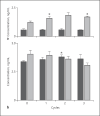Determination of the Endocannabinoids Anandamide and 2-Arachidonoyl Glycerol with Gas Chromatography-Mass Spectrometry: Analytical and Preanalytical Challenges and Pitfalls
- PMID: 34676317
- PMCID: PMC8489342
- DOI: 10.1159/000489032
Determination of the Endocannabinoids Anandamide and 2-Arachidonoyl Glycerol with Gas Chromatography-Mass Spectrometry: Analytical and Preanalytical Challenges and Pitfalls
Abstract
Background: The endocannabinoids anandamide (N-arachidonoyl ethanolamide [AEA]) and 2-arachidonoyl glycerol (2-AG) are involved in the regulation of neuronal, immune, metabolic, vascular, and reproductory functions.
Methods: The development and validation of an analytical method for the determination of AEA and 2-AG in human plasma based on liquid-liquid extraction and gas chromatography-mass spectrometry after silylation is described and (pre)-analytical pitfalls are identified.
Results: In contrast to 2-AG, AEA was unstable in whole blood and increased by a factor of 2.3 within 3 h on ice. AEA was stable in plasma on ice for 4 h while 2-AG tended to decrease. Excellent stability at room/ambient temperature was found for both derivatized compounds over 45 h. Furthermore, 3 freeze-thaw cycles revealed a complex pattern: endogenous AEA was stable in plasma but slightly increased in spiked samples (+12.8%), while endogenous 2-AG concentrations increased by 51% and declined by 24% in spiked samples. A long-term study over 4 weeks at -80°C showed that low endogenous AEA and spiked 2-AG concentrations were stable. However, spiked AEA tended to increase (+19%) and endogenous 2-AG significantly increased by 50% after 2 weeks. Food intake 2 h before blood collection showed no effect on AEA concentrations, whereas 2-AG increased significantly by a factor of 3.
Conclusions: Overall, limited in vitro and/or in vivo/ex vivo chemical stability of endocannabinoids has to be taken into account.
Keywords: 2-Arachidonoyl glycerol; Anandamide; Endocannabinoids; Gas chromatography-mass spectrometry; Human plasma; Pitfalls.
Copyright © 2018 by S. Karger AG, Basel.
Conflict of interest statement
The authors have declared no conflict of interest.
Figures






Similar articles
-
Endocannabinoids as potential biomarkers: It's all about pre-analytics.J Mass Spectrom Adv Clin Lab. 2021 Nov 10;22:56-63. doi: 10.1016/j.jmsacl.2021.11.001. eCollection 2021 Nov. J Mass Spectrom Adv Clin Lab. 2021. PMID: 34939056 Free PMC article.
-
Simultaneous UPLC-MS/MS quantification of the endocannabinoids 2-arachidonoyl glycerol (2AG), 1-arachidonoyl glycerol (1AG), and anandamide in human plasma: minimization of matrix-effects, 2AG/1AG isomerization and degradation by toluene solvent extraction.J Chromatogr B Analyt Technol Biomed Life Sci. 2012 Feb 1;883-884:161-71. doi: 10.1016/j.jchromb.2011.06.025. Epub 2011 Jun 22. J Chromatogr B Analyt Technol Biomed Life Sci. 2012. PMID: 21752730
-
Determination of endocannabinoids and endocannabinoid-like substances in human K3EDTA plasma - LC-MS/MS method validation and pre-analytical characteristics.Talanta. 2019 Nov 1;204:386-394. doi: 10.1016/j.talanta.2019.06.004. Epub 2019 Jun 3. Talanta. 2019. PMID: 31357310
-
Quantification of endocannabinoids in biological systems by chromatography and mass spectrometry: a comprehensive review from an analytical and biological perspective.Biochim Biophys Acta. 2011 Nov;1811(11):706-23. doi: 10.1016/j.bbalip.2011.08.004. Epub 2011 Aug 19. Biochim Biophys Acta. 2011. PMID: 21875688 Review.
-
Metabolism of endocannabinoids.Postepy Hig Med Dosw (Online). 2016 Aug 11;70(0):830-43. doi: 10.5604/17322693.1213898. Postepy Hig Med Dosw (Online). 2016. PMID: 27516570 Review.
Cited by
-
A role for the endocannabinoid enzymes monoacylglycerol and diacylglycerol lipases in cue-induced cocaine craving following prolonged abstinence.Addict Biol. 2021 Sep;26(5):e13007. doi: 10.1111/adb.13007. Epub 2021 Jan 25. Addict Biol. 2021. PMID: 33496035 Free PMC article.
-
A UPLC-MS/MS method for simultaneous determination of arachidonic acid, stearic acid, and related endocannabinoids in human plasma.Heliyon. 2024 Mar 21;10(7):e28467. doi: 10.1016/j.heliyon.2024.e28467. eCollection 2024 Apr 15. Heliyon. 2024. PMID: 38560270 Free PMC article.
-
Circulating Endocannabinoids in Canine Multicentric Lymphoma Patients.Front Vet Sci. 2022 Feb 15;9:828095. doi: 10.3389/fvets.2022.828095. eCollection 2022. Front Vet Sci. 2022. PMID: 35242839 Free PMC article.
-
Cannabinoids as Prospective Anti-Cancer Drugs: Mechanism of Action in Healthy and Cancer Cells.Adv Exp Med Biol. 2023;1410:145-169. doi: 10.1007/5584_2022_748. Adv Exp Med Biol. 2023. PMID: 36396926
-
Anandamide and 2-arachidonoylglycerol baseline plasma concentrations and their clinical correlate in gambling disorder.Eur Psychiatry. 2023 Nov 8;66(1):e97. doi: 10.1192/j.eurpsy.2023.2460. Eur Psychiatry. 2023. PMID: 37937379 Free PMC article.
References
-
- Hanus LO. Pharmacological and therapeutic secrets of plant and brain (endo)cannabinoids. Med Res Rev. 2009;29:213–271. - PubMed
-
- Howlett AC. Inhibition of neuroblastoma adenylate cyclase by cannabinoid and nantradol compounds. Life Sci. 1984;35:1803–1810. - PubMed
-
- Howlett AC, Fleming RM. Cannabinoid inhibition of adenylate cyclase. Pharmacology of the response in neuroblastoma cell membranes. Mol Pharmacol. 1984;26:532–538. - PubMed
-
- Devane WA, Dysarz FA, 3rd, Johnson MR, Melvin LS, Howlett AC. Determination and characterization of a cannabinoid receptor in rat brain. Mol Pharmacol. 1988;34:605–613. - PubMed
LinkOut - more resources
Full Text Sources
Other Literature Sources

